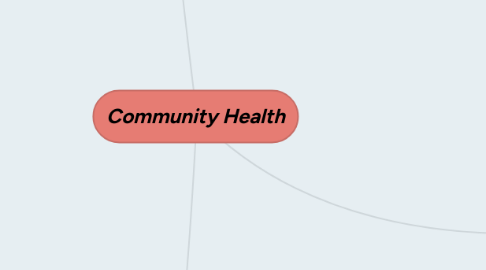
1. Difinition
1.1. Community
1.1.1. A brief history of community
1.1.2. Concept and principle of community health
1.2. Health system
1.2.1. Approaches to defining “community health”
1.2.2. Health determinants in the community
1.2.2.1. Individual behaviors
1.2.2.2. Community organization
1.2.2.3. Social and cultural factors
1.2.2.4. Physical factor
1.2.3. Definition of health promotion in community
1.2.4. Definition of control disease in community
1.2.5. Definition of protect health in community
1.2.6. Service prosition
1.2.6.1. Community health care services
1.2.6.2. Primary health care services
1.2.6.2.1. Health centers located
1.2.6.2.2. Key health workforce working
1.2.6.3. Secondary health care services
1.2.6.3.1. Key health workforce working
1.2.6.4. Tertiary health care services
1.2.6.4.1. General hospitals
1.2.6.4.2. Regional hospitals
1.2.6.4.3. Medical school hospitals
1.2.6.4.4. Specialty hospitals
1.2.6.4.5. Large private hospitals
2. Process
2.1. The process of preparing the community for the community health diagnosis
2.1.1. Community health assessment
2.1.1.1. create 7 instruments for community study
2.1.1.1.1. Community mapping, Geo Social Mapping
2.1.1.1.2. Genogram
2.1.1.1.3. Community Organizations
2.1.1.1.4. Local Health System
2.1.1.1.5. Community Calendar
2.1.1.1.6. Local History
2.1.1.1.7. Life Story
2.1.1.2. Health information system
2.1.1.2.1. Quantitative Flavors
2.1.1.2.2. Qualitative Flavors
2.1.1.3. Data collecting in health care system
2.1.1.3.1. Primary data
2.1.1.3.2. Secondary data
2.1.2. Community diagnosis and Priority setthing
2.1.2.1. Feedback of health problem to the community
2.1.3. Planning for solving of problem
2.1.3.1. Principal of planning
2.1.3.2. AIC technique (Appreciation-Influence-Control)
2.1.3.3. Create Project
2.1.3.3.1. Methods to do project
2.1.3.3.2. Strategies to set up health project in the community
2.1.3.3.3. Health project in community leve and plan developmentl
2.1.3.3.4. Convention project and log frame
2.1.4. Evaluation
2.1.4.1. evaluation technique
2.1.4.2. Tool
3. Technical and Tools for study community
3.1. Observation การสังเกตการณ์
3.1.1. Participant Observation การสังเกตการณ์อย่างมีส่วนร่วมอย่างใกล้ชิด
3.1.2. Non-Participant Observation การสังเกตการณ์แบบไม่มีส่วนร่วมอย่างใกล้ชิด
3.2. Interview การสัมภาษณ์
3.2.1. Type of interview
3.2.1.1. Focused Interview การสัมภาษณ์แบบเจาะจง
3.2.1.2. Non – directive Interview การสัมภาษณ์ที่ไม่กำหนดคำตอบล่วงหน้า
3.2.1.3. Indepth Interviewการสัมภาษณ์แบบลึกซึ้ง หรือแบบเจาะลึก
3.2.1.4. Repeated Interview4. การสัมภาษณ์ซ้ำ
3.2.1.5. Type divided by interviewing techniques
3.2.1.5.1. การสัมภาษณ์อย่างมีโครงสร้าง (Structured Interview)
3.2.1.5.2. การสัมภาษณ์อย่างไม่มีโครงสร้าง (Unstructured Interview)
3.2.1.5.3. (Semi- structured Interview)การสัมภาษณ์การสัมภาษณ์แบบกึ่งโครงสร้าง
3.2.2. Principle for interview
3.2.2.1. การแนะนำตัว (Introduction)
3.2.2.2. การสร้างความสัมพันธ์ที่ดี (Good Relationship)
3.2.2.3. การเข้าใจวัตถุประสงค์ (Objectives)
3.2.2.4. การจดบันทึก (Take Note)
3.2.2.5. การสังเกตการณ์ (Observing)
3.2.2.6. การฟัง (Listening)
3.2.2.7. การซักถาม (Questioning)
3.2.2.8. การถามซ้ำ (Probing)
3.2.2.9. การกล่าวขอบคุณ (Thanks)
3.3. การสนทนากลุ่ม (Focus group)
3.3.1. องค์ประกอบComposition
3.3.1.1. บุคลากรที่เกี่ยวข้อง
3.3.1.1.1. 1. ผู้ดำเนินการสนทนา (Moderator)
3.3.1.1.2. 2. ผู้จดบันทึกการสนทนา (Notetaker)
3.3.1.1.3. 3. ผู้ช่วย (Assistant)
3.3.1.2. แนวทางในการเตรียมการสนทนากลุ่ม
3.3.1.3. อุปกรณ์สนาม
3.3.1.3.1. เครื่องบันทึกเสียง
3.3.1.3.2. สมุดบันทึก และดินสอ
3.3.1.4. แบบฟอร์มสำหรับคัดเลือกผู้เข้าร่วมสนทนากลุ่ม
3.3.1.5. ส่งเสริมสร้างบรรยากาศ
3.3.1.5.1. เครื่องดื่ม
3.3.1.5.2. ของขบเคี้ยว
3.3.1.6. ของสมนาคุณแก่ผู้ที่ร่วมสนทนา
3.3.1.7. สถานที่และระยะเวลา
3.4. การใช้ข้อมูลเอกสาร
3.4.1. สถิติและบันทึกต่างๆ
3.4.1.1. บันทึกประจำวัน
3.4.1.2. ประวัติบุคคล
3.4.2. เอกสาร
3.4.2.1. แผนผัง
3.4.2.2. รูปภาพ
3.5. การเข้าสนาม
3.5.1. 1. วางท่าทีสงบเสงี่ยม ไม่ทำตัวให้เด่นจนผิดสังเกต
3.5.2. 2. หลีกเลี่ยงการถามคำถามที่ทำให้ชาวบ้าน/ผู้ตอบรู้สึกอึดอัด
3.5.3. 3. อย่าพยายามทำตัวทัดเทียมผู้นำชาวบ้าน
3.5.4. 4. พยายามเข้าไปมีส่วนร่วมในเหตุการณ์ต่างๆ ที่เกิดขึ้นในชุมชน
3.5.5. 5. หาใครคนหนึ่งเป็นผู้เริ่มแนะนำเราให้รู้จักกับชาวบ้าน
3.5.6. 6. เป็นมิตรกับทุกคน
3.6. การศึกษาแบบผสมผสาน
3.6.1. 1. การสัมภาษณ์ ทั้งแบบมีโครงสร้าง (มีแบบสอบถาม) และไม่มีโครงสร้าง
3.6.2. 2. การสนทนาพูดคุยทั้งอย่างเป็นทางการและไม่เป็นทางการ
3.6.3. 3. การสังเกตอย่างมีส่วนร่วมและการสังเกตอย่างไม่มีส่วนร่วม
3.6.4. 4. การจดบันทึกประจำวัน
3.6.5. 5. การสัมภาษณ์เจาะลึก Key Information

